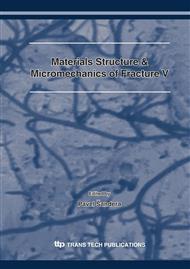[1]
C.H. Cáceres and A.H. Blake: Mater. Sci. Engng. A Vol. 462 (2007), p.193.
Google Scholar
[2]
D. Kuhlmann-Wilsdorf: Metall. Mater. Trans. A Vol. 35 (2004), p.369.
Google Scholar
[3]
A. Seeger, in: Dislocations and mechanical properties of crystals, edited by J.C. Fisher, W.G. Johnston, R. Thomson and T. Vreeland (Chapman and Hall, London, 1957), p.243.
Google Scholar
[4]
A. Akhtar and E. Teghtsoonian: Acta Metall. Vol. 17 (1969), p.1339.
Google Scholar
[5]
A. Akhtar and E. Teghtsoonian: Acta Metall. Vol. 17 (1969), p.1351.
Google Scholar
[6]
R.W. Armstrong, in: T.N. Baker (Ed. ) Yield, flow and fracture of polycrystals, (Applied Science Publishers, London, 1983), p.1.
Google Scholar
[7]
A.H. Blake and C.H. Cáceres: Mater. Sci. Engng. A http: /dx. doi. org/10. 1016/j. msea. 2006. 10. 205 (2007).
Google Scholar
[8]
G.E. Mann, T. Sumitomo, C.H. Cáceres, and J.R. Griffiths: Mater. Sci. Engng. A Vol. 456 (2007), p.138.
Google Scholar
[9]
J. Bohlen, P. Dobron, J. Swiostek, D. Letzig, F. Chmelik, P. Lukac, and K.U. Kainer: Mater. Sci. Engng. A http: /dx. doi. org/10. 1016/j. msea. 2006. 02. 470 (2007).
Google Scholar
[10]
E.W. Kelley and W.F. Hosford: Trans. AIME Vol. 242 (1968), p.5.
Google Scholar
[11]
A. Jain and S.R. Agnew: Mater. Sci. Engng. A http: /dx. doi. org/10. 1016/j. msea. 2006. 03. 160 (2007).
Google Scholar
[12]
K. Mathis, F. Chmelik, M. Janecek, B. Hadzima, Z. Trojanova, and P. Lukac: Acta Mater. Vol. 54 (2006), p.5361.
Google Scholar
[13]
E. Meza-Garcia, P. Dobron, J. Bohlen, D. Letzig, F. Chmelik, P. Lukac, and K.U. Kainer: Mater. Sci. Engng. A http: /dx. doi. org/10. 1016/j. msea. 2006. 02. 469 (2007).
Google Scholar
[14]
C.H. Cáceres and A. Blake: phys. stat. sol. Vol. 194 (a) (2002), p.147.
Google Scholar
[15]
J.C. Fisher: Acta Metall. Vol. 2 (1954), p.9.
Google Scholar
[16]
A. Blake and C.H. Cáceres, in: N.R. Neelameggham, H.I. Kaplan and B.R. Powell (Eds. ) Magnesium Technology 2005, San Francisco; 2005 (TMS, Warrendale), 403.
Google Scholar
[17]
U.F. Kocks and H. Mecking: Prog. Mater. Sci. Vol. 48 (2003), p.171.
Google Scholar
[18]
M.R. Barnett, Z. Keshavarz, A.G. Beer, and D. Atwell: Acta Mater. Vol. 52 (2004), p.5093.
Google Scholar
[19]
S.R. Agnew, M.H. Yoo, and C.N. Tomé: Acta Mater. Vol. 49 (2001), p.4277.
Google Scholar
[20]
G.E. Mann, T. Sumitomo, C.H. Cáceres, and J.R. Griffiths: Mater. Sci. Engng. A Vol. 456 (2007), p.138.
Google Scholar
[21]
S.R. Agnew, C.N. Tomé, D.W. Brown, T.M. Holden, and S.C. Vogel: Scripta Mater. Vol. 48 (2003), p.1003.
Google Scholar
[22]
S.N. Tiwari and K. Tangri: Mater. Sci. Engng. Vol. 57 (1983), p.31.
Google Scholar


